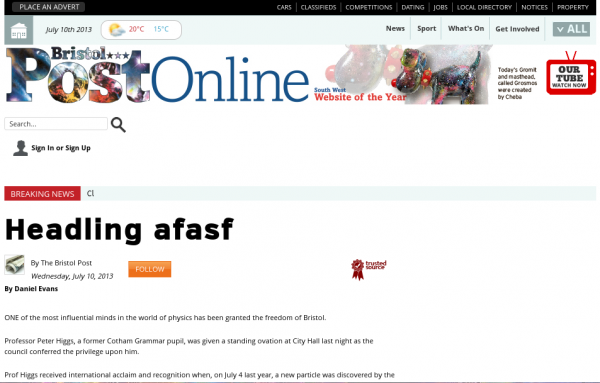A message to thieves
I’ve seen this fruit van a few times on Cumberland Road in recent weeks. At the foot of the offside door is a message to the light-fingered with a penchant for bananas.

Only in Bristol… 🙂
I’ve seen this fruit van a few times on Cumberland Road in recent weeks. At the foot of the offside door is a message to the light-fingered with a penchant for bananas.

Only in Bristol… 🙂
Yesterday I returned from my annual meet-up in Shropshire with my sister Hilary. Dubbed the ‘sibling saunter’, it’s an opportunity we take each year to meet in Shropshire, the county of our birth, and go walking without the encumbrance of children, partners, etc.
This year we went down into the Clun area in the south-west of Shropshire and the first day’s walk took us into Wales. Following an excellent route map (PDF) prepared by the Clwyd-Powys Archaeological Trust, we visited the prehistoric burial cairns on Corndon Hill (513 m above sea level) before making to the Miner’s Arms in Priestweston for a pint and finishing off at the Mitchell’s Fold stone circle. Legend has it that one of the stones in the circle is a petrified witch, punished by locals for seeing off a magic cow that provided them with unending supplies of milk.
There’s a very convenient bench next to the trig point on the top of Corndon Hill and it’s perfect for a breather and a refreshment stop.
Just south of Corndon Hill is a small outcrop of a volcanic rock known as picrite. This was used to make stone axes at around the same time that the burial cairns and stone circle were constructed. CPAT has investigated this prehistoric quarry, also known as Cwm Mawr.

The porous, unclear nature of the border between England and Wales is well evidenced around this area by places with English names in Wales and Welsh ones in England. The border itself has moved around too. For instance, Montgomery – the site of one of the Marcher castles and now firmly part of Wales – is included in the Shropshire county returns of the Domesday Book.
Although our Corndon Hill walk was only 6 miles in length, we both agreed on its strenuous nature for fifty-somethings, albeit fairly fit ones.
As the first evening of our annual saunter set in, we were still undecided as to the next day’s walking route. Eventually we decided on a loop of some 10 miles in length comprising a section of the Shropshire Way to Hergan and its junction with the Offa’s Dyke Path, which here is well preserved and follows the line of the Dyke itself, down to Newcastle on Clun and then back to our base at the youth hostel in Clun.
Offa’s Dyke is a massive linear earthwork, roughly followed by some of current border between England and Wales. In places, it is up to 19.8 m wide – including its flanking ditch – and 2.4 m high, with the ditch always on the Welsh side. In the 8th century it formed some kind of delineation between the Saxon kingdom of Mercia and the Welsh. Offa himself was King of Mercia from 757 to 796.
So we set out from the grounds of Clun Castle following the Shropshire Way along the valley of the River Clun. The route is well waymarked and the Shropshire Way’s buzzard logo is well displayed on all signposts. After a couple of miles we climbed over the Cefns to Hengarn and Offa’s Dyke.

The section of the Shropshire Way over which we’d walked was shared with Wild Eadric’s Way, named after Eadric the Wild, a Saxon thegn (or thane. Ed.) who was lord of Clun and refused to swear fealty to the usurping William the Bastard of Normandy. The factual life of Eadric has since become interspersed with folklore, as shown in this article.
But back to Offa’s Dyke. The section we were walking is amongst the best preserved that remains. Furthermore, whilst descending to Newcastle on Clun, we passed the halfway point between the path’s 2 end points – Chepstow and Prestatyn. It was most fortunate we were walking on a Wednesday as there’s a community café open in Newcastle’s community centre on Wednesdays between 10.30 am and 4.30 pm; the refreshments were excellent! I recommend the ginger and lemon cake.
Once back in Clun it was time for a well-earned pint in the Sun Inn before retiring back to the youth hostel. If you’re thinking of staying in the area and have fond memories of ‘old skool’ hostelling, you’ll love Clun YH. It’s a beautifully restored water mill with plenty of the mill machinery on view. Furthermore, it’s one of those hostels where people talk to one another. Before drawing to a close, I’d like to thank Sue the volunteer warden on duty during our stay for her helpfulness and very cheery disposition. We both hope the bedding inventory didn’t do your head in! 🙂
We’re taking the sibling saunter back to the Clun and Bishops Castle area next year to explore inter alia the Iron Age hill fort of Bury Ditches.
Update: 24/08/13: About the time this post was published yesterday, the Shropshire Star reported that a section of Offa’s Dyke in Wales has been destroyed by bulldozer. Police and Cadw, the Welsh heritage organisation, are continuing to investigate how the earthwork alongside the A5 north of Chirk, came to be flattened in this blatant act of vandalism. Jim Saunders of the Offa’s Dyke Association is reported to have said: “The ditch could be dug out but the dyke has been destroyed now it will never be the same again.”
Yesterday’s Bristol Post featured a report on convicted murderer Paul Flint, who has absconded from Ford Open Prison in Sussex.
Flint is believed to be in the Bristol area, the evidence for which is included in the following sentence:
The latest reported sighting of Flint was on a train at Bristol Parkway station, heading towards Westbury-on-Trym, shortly after 6.20pm on Tuesday.
There’s one major problem with that statement: no railway line runs between Bristol Parkway and Westbury-on-Trym. The closest any line runs to Westbury-on-Trym is the Henbury Loop line (posts passim), which has been closed to passenger traffic since 1964.
Is there a chance that reporter Daniel Evans was confusing Westbury-on-Trym with Westbury in Wiltshire, which does have a functioning railway station – or does he live in a Bristol in a parallel universe where public transport provision is excellent? 😉
Yahoo News reports that the Advertising Standards Authority (ASA) is investigating the recent Home Office poster van campaign targeting immigrants and dubbed the ‘racist van’ due to the crass insensitivity that is a hallmark of the Whitehall PR machine nowadays (posts passim).

The ASA has so far received 60 complaints expressing concerns that the advertisements were “reminiscent of slogans used by racist groups to attack immigrants in the past”.
The racist van was driven around the London boroughs of Barnet, Hounslow, Barking & Dagenham, Ealing, Brent and Redbridge – all areas with a high percentage of ethnic minority residents – as part of a £10,000 Home Office pilot scheme, which ended at the end of July.
As a counterpart to the Home Office’s mobile billboard, human rights and civil liberties organisation Liberty drove its own ‘anti-racist van’ around the streets of the metropolis.

Yesterday I left the confines of Bristol and travelled down to the Bristol Channel coast.
While there I was there I made time to visit an area of salt marsh to forage for marsh samphire (also known as glasswort), which is currently in the midst of its short season, which consists of the months of July and August only.

Samphire can be eaten raw or cooked. In the latter instance, no salt needs to be added to the cooking water as the plant has an inherent high salt content. It has a fresh, salty taste, crisp texture and makes a great accompaniment to fish and shellfish dishes, eggs or such specialities as salt marsh lamb. As samphire gets older and larger, the core of the plant becomes more stringy and the succulent flesh has to be stripped off the stringy core.
Until the start of the 19th century, marsh samphire also had industrial uses: before the introduction of the LeBlanc process for the industrial production of soda ash, marsh samphire ashes were long used as a source of soda ash (mainly sodium carbonate) for making glass and soap.
As regards the origin of the noun samphire, it is believed to be a corruption of the French name herbe de Saint-Pierre, i.e. “St Peter’s herb”.
No further comment necessary!

The second Ashes Test match is currently underway at Lord’s in London between England and Australia.
Over the years I’ve become a fan of the live coverage provided by the Test Match Special team on Radio 4 LW; local Bristol community station BCfm interferes with the signal on Radio 4’s FM signal where I live.

One of the joys of listening to the coverage is the banter between the team, especially the ribbing of Boycott and the interplay between him and Aggers in particular.
Now Geoffrey is not known for keeping his counsel to himself, being a man of strong opinions. Like all of us, he’s got little foibles in his speech and recurring phrases, affectionately known as ‘Boycottisms‘. These Boycottisms have been used to produce ‘Boycott bingo’ cards like the example below.

You can get your own Boycott bingo card at http://boycott.gdb.me/.
Play along and enjoy the game!
KDE is one of the 2 major providers of GUIs and applications for Linux systems (some KDE applications are also now available for Windows too! Ed.).
It’s currently holding the KDE Akademy 2013, a free, non-commercial event organised by the KDE community, in Bilbao in the Basque Country of Northern Spain from 13th to 19th July.
The local public transport company has also picked up on this event and is advertising it on its ticket machines; and in 3 languages too!.

Would London Underground or the UK’s train operating companies do likewise?
I’ve written before of my dislike of advertising (posts passim), but advertising for community-based projects – even if those communities are scattered throughout the world – is something for which I’ll make an exception.
Below is a screenshot of the story in today’s Bristol Post reporting on Professor Peter Higgs – one of the team that postulated the existence of the particle named after him back in the 1960s – being granted the freedom of the city of Bristol.

Professor Higgs is a former pupil of Bristol’s Cotham Grammar School.
For a local media report of the event that has a proper headline, I recommend Bristol 24/7’s offering.
Bristol & Avon Family History Society has some interest background information on the history of the Freedom of Bristol and Burgesses, as Freemen (and they were men in medieval times. Ed.) were originally known.
As the screenshot below shows, Capita, that paragon of outsourcing efficiency, is due to appear at 9.30 at Blackfriars Crown Court in London before His Honour Judge Marron QC regarding “Interpreter Issues”, presumably the failure of Capita Translation & interpreting to fulfil its courts and tribunals interpreting contract with the Ministry of Justice (posts passim).

Update: 10.00 am.Peter Shortall has just commented as follows on the RPSI Facebook page:
Just left Blackfriars CC. It’s being heard in chambers, so I and a lady who had turned up to watch were asked to leave so the judge could talk to the Capita rep privately. So much for transparency!
Peter also added in an earlier comment that Neal Kelly is Capita’s “relationship manager” who handles “high-level complaints”.